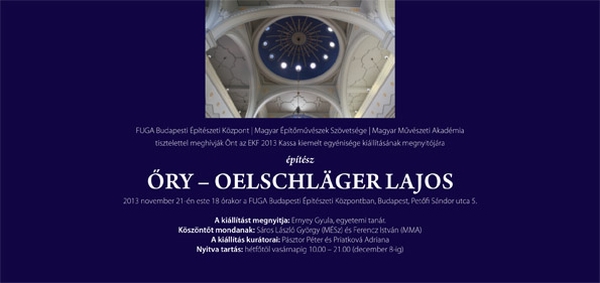OelschlûÊger / Lajos éry
FUGA Budapest Center of Architecture
21 November – 8 December 2013

Architect á§udovûÙt OelschlûÊger (1896ã1984), a native of KoéÀice, studied architecture in Budapest. After graduation he gained practical experience at architectural offices in Berlin, Munich and Stuttgart. In 1924 he returned to KoéÀice. Apart from his native town, his works can also be seen in other towns in Slovakia and Sub-Carpathian Ruthenia. He is an author of the Orthodox synagogue, Forum (Slovan) Cinema, open-air swimming pool, and other buildings in KoéÀice, which are well known to the inhabitants. The aim of the exhibition devoted to architectural work of á§udovûÙt OelschlûÊger in the 1920s and 1930s is to reveal the unknown past of popular buildings.
Architecture is probably the most comprehensive art; since Antiquity, architecture has been called a mother of all arts. It is a very difficult art discipline, as the implementation of architectôÇs idea largely depends on the competence of constructors, materials available as well as on financial, cultural and social conditions under which the building is erected. The end result is always affected by all the aforementioned factors.
The most important for the end result is the personality of an architect, who often becomes, with effective support of the constructor (investor), a coordinator and leader of a realization team. The architect must understand that good architecture is more than merely a beautiful, well-constructed, well-proportioned and functional building made of high-quality materials, and that real architecture begins with an appropriate integration of the building into and harmonisation with natural setting and ends with excellent details. Moreover, high-quality architecture appeals not only to the users but also to all people passing by.
From this perspective, the work of á§udovûÙt OelschlûÊger seems to be fully unique and can be perceived as a message to future generations. His buildings designed and completed in interwar period, such as Forum (Slovan) Cinema, fire station, the Chamber of Commerce and Industry, Orthodox synagogue, open-air swimming pool and former Czech consulate in KoéÀice, Sanatorium at Bankov, town halls in Tornaáƒa and Michalovce, Scala (TokajûÙk) Cinema in PreéÀov, the extension to the Sanatorium of Dr. Guhr in TatranskûÀ Polianka and the restaurant Taverna at the Grand Hotel in Starû§ Smokovec, can be considered illustrative examples of humility and natural elegance with which the new architecture should integrate into historical setting. OelschlûÊgerôÇs architectural language is clearly legible and very cultivated. People entering his buildings are impresssed by a solemn atmosphere, and thatôÇs exactly what the real architecture should be about!
In our opinion it is necessary to present the work of this hitherto lesser know architect not only to the inhabitants of KoéÀice but also to the town visitors. In this connection it is irrelevant that OelschûÊger professed Hungarian nationality, was a member of the Order of Heroes (Vitûˋz Order) and therefore changed his name to éry Lajos, or that after the end of WWII he was compelled to leave KoéÀice and spent the rest of his life in Hungary. Only the buildings he left behind in his beloved KoéÀice are important! We are glad that the presentation of this unique personality ãto the town and to the worldã takes place in the year when KoéÀice beat the title the European Capital of Culture.
Prof. Ing. arch. Peter PûÀsztor, PhD.
Ing. arch. Adriana PriatkovûÀ, PhD
